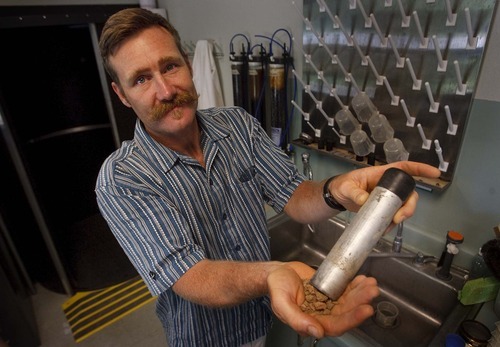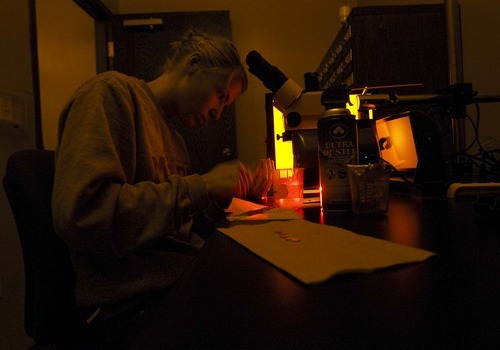This is an archived article that was published on sltrib.com in 2011, and information in the article may be outdated. It is provided only for personal research purposes and may not be reprinted.
North Logan • Utah State University geologists Tammi Rittenour and Joel Pederson believe a grain of sand says a lot about artifacts and landscapes — as long as it's been kept in the dark before reaching their lab.
One of only 10 such facilities in the nation, their Luminescence Lab on USU's Innovation Campus is helping scientists understand the forces of erosion on the land, determine when earthquakes last struck, and establish a range on the age of rock art and other cultural relics that don't lend themselves to traditional dating techniques.
Using luminescence, Pederson has been able to determine a Canyonlands pictograph panel is at least 900 years old. Pictographs are notoriously immune to dating, so Pederson researched not when the image was painted, but when a chunk of the panel broke off and landed face down in the dirt.
Optically stimulated luminescence, or OSL, doesn't date the interesting material the way radiocarbon dating does, but rather the last time sand grains associated with it were exposed to light. Samples must be gathered in a way that won't allow light to hit them — which would reset their signal — and taken to the lab. Grains of quartz are isolated for analysis by exciting the electrons inside the sand grains.
"When [the electrons] fall back, they release a tiny amount of light and that's what we're measuring," Pederson said during a recent tour of the small lab. "The amount of light they give off is directly proportional to how long it has been buried."
The lab, which opened in 2007 thanks to an equipment-purchase grant from the Browning Foundation, is the only one of its kind in the Intermountain West. It runs hundreds of samples a year, at a cost of about $1,000 a pop. About half the projects are geared toward archaeological studies and the rest toward geomorphology, the study of how landscapes and the earth evolve.
University of Minnesota geology student Michelle Williams was recently using the darkened lab as part of her investigation into a suspected glacial lake back home. Under the illumination provided by amber light, she was isolating grains of sands and securing them in discs to be inserted in luminescence readers.
"We're going to run that to get an age above and below the lake bed's clay," said Williams, now an exchange student at the University of Utah.
While their research interests focus on geomorphology, Rittenour and Pederson often assist archaeological inquiries about intriguing artifacts left by the Southwest's ancient inhabitants, including irrigation channels in Arizona and New Mexico. Rittenour analyzed sand grains imbedded in a flute recovered from Range Creek Canyon, the remote archaeological region inhabited by prehistoric Fremont Indians. Her findings, while not precise, did rule out an historic origin for the artifact, she said.
Rittenour, the lab's director, recently won a prestigious National Science Foundation grant to study arroyo cutting in southern Utah. These grants are reserved to help develop the careers of promising young faculty.
The money is helping her and her students use luminescence, along with other dating techniques such as tree ring analysis and radiocarbon dating, to determine precisely when catastrophic floods carved arroyos in the late 19th and early 20th centuries. Arroyos are formed after floodwaters rip down canyons, leaving deep flat-bottom channels. She believes they occur in cycles separated by several hundred years.
"As we examine the different arroyo sections — located near the upper Paria River, the Virgin River, Kanab Creek and the Escalante River — we'll hold as many factors the same as possible," said Rittenour, an assistant professor of geology. "We want to know whether or not these incision episodes have happened synchronously. That will yield important clues about what's causing these cycles."
OSL offers many advantages over radiocarbon, which requires the presence of organic material, because it can look much further back in time, as much as 300,000 years, versus 60,000.
"That last few hundred thousand is neat because that's the time frame at which things remain in the landscape you can see," Pederson said. "When geologists talk about millions of years, then you're looking at rocks and things that are out of context."
But more importantly, researchers can reliably tap OSL since buried sand is almost always available at a research site, while the presence of carbon, an element found in wood and other once living things, can be a crap shoot.
In another rock art investigation, Pederson dated the sediments in a river wash to determine that Barrier Canyon Style pictograph panels associated with the Great Gallery in Canyonlands were no older than 6,000 years. The places where the images, featuring the style's distinctive trapezoidal figures, were painted was under sand before that, he said. Again, it wasn't a very precise window, but at least the finding ruled out some hypotheses on the origins of the images while supporting others.
Optically stimulated luminescence
How it works • Scientists isolate grains of quartz that have been buried, splash them with light and measure their response. These measurements can reveal the last time the grains were exposed to sunlight as far back as 300,000 years, give or take 5 to 10 percent.





